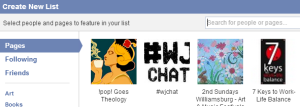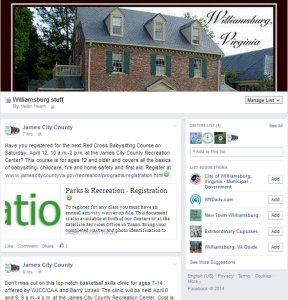Helen's Blog, a/k/a The Mosher Pit
Brain noise, tunes and pics, and occasional insight from Helen Heath Mosher.
OBX-centric
Facebook Users: Are You Being Served?
There’s been a lot of chatter of late regarding changes Facebook continues to make to its algorithm for serving content to its users. But most of that chatter has been focused on page admins–things you can do to try and get around FB’s ongoing attempts to goad brands into paying for their content to get distributed, regardless of each brand’s potential budget for doing so. This pay-to-play system seems to me an attempt to make the companies that profit from their presence on FB shell out some “rent” for doing so, and that isn’t totally unfair. But what of the websites, blogs, fan pages and nonprofits that do NOT profit from their presence on FB? And what of you, the users who actually want their content?
![]() Today, FB muddied the page admin waters further by telling us that you’re not necessarily even seeing our posts even if FB is “serving” them to you. So all we know is how many times FB throws our posts into your feeds, and by golly, the numbers tell us it’s not very often–whether it’s how it’s served or how it’s seen. Honestly, the marketing folks will spend hours and hours researching how to game these feeds to reach you more frequently, but ultimately, *you* have opted in to our updates and as such it’s up to *you* to customize your FB use to better see us, if you really want to see us. (And we hope you do.)
Today, FB muddied the page admin waters further by telling us that you’re not necessarily even seeing our posts even if FB is “serving” them to you. So all we know is how many times FB throws our posts into your feeds, and by golly, the numbers tell us it’s not very often–whether it’s how it’s served or how it’s seen. Honestly, the marketing folks will spend hours and hours researching how to game these feeds to reach you more frequently, but ultimately, *you* have opted in to our updates and as such it’s up to *you* to customize your FB use to better see us, if you really want to see us. (And we hope you do.)
So, without further ado, here are three ways you can make sure you’re seeing page posts while using Facebook:
1. Use the Page Feed

The page feed generates a real-time feed of pages you’re a fan of. By real-time, I mean the kind of feed that puts things in order based more on recent comments than on recent posts, an ongoing problem wherein Facebook thinks it knows what you want better than you do. Oh, wait, I am digressing. But if your “recent activity” feed is full of your friends’ posts, the pages feed will give you the closest approximation of the same feed but with page content instead of friend’s content.
It’s easy to access and save: Look for the orange flag in the left-hand navigation of your Facebook page, or just access your Facebook page feed directly.
2. Use Interest Lists
Interest pages generate a specialized feed with content that you specify. They are different from Friend lists in that you can actually set them up in a way that others can access them. That said, I prefer to create my own. I recently was offered a job in an area I don’t know all that well, so I started seeking out pages in that area to like so I could learn more about it.

Facebook remembers that you’ve bundled posts together this way and will at times let you know that there are new posts in the list.
Add a page to a list by accessing the dropdown menu at “Liked.” Choose “Add to Interest Lists,” and you will get a picklist of existing lists or the option to create a new list.

When creating a new list, you’ll be prompted to add other pages to the list–or people you follow, or friends. Basically, suppose you are into yoga. You can add yoga pages, yoga experts you follow, and friends whose FB focus is primarily yoga to your yoga list and have a topical stream dedicated to information about yoga.

Once you create a list, you’ll want to be able to come back to it easily. There are two ways to do this. The first way: Create a bookmark file in your browser and save links to lists you want to access from one click. The other way: Add the list to “favorites” and it will always appear in the left-hand navigation of your Facebook page.
Then, when you load your FB list, you’ll be presented with an easy to scroll-through feed of topically-related page content!

3. Turn notifications on
 For those pages that have can’t miss content–your favorite news sites or magazines, that college you’re dying to attend, the blog you want to see every post from but can’t remember to check now that Google Reader is dead–whatever the case: You can turn on notifications for your absolute favorite pages. Of course, this assumes you have notifications turned on in the first place, but nothing makes me happier than seeing a notification pop up that the rarely-updated association page I want updates from has finally posted info on an upcoming conference I want to attend. It’s a post I’d miss in the grand scale of noise on FB, but I don’t want to miss it and I definitely don’t want to rely on Facebook to “serve” it to me.
For those pages that have can’t miss content–your favorite news sites or magazines, that college you’re dying to attend, the blog you want to see every post from but can’t remember to check now that Google Reader is dead–whatever the case: You can turn on notifications for your absolute favorite pages. Of course, this assumes you have notifications turned on in the first place, but nothing makes me happier than seeing a notification pop up that the rarely-updated association page I want updates from has finally posted info on an upcoming conference I want to attend. It’s a post I’d miss in the grand scale of noise on FB, but I don’t want to miss it and I definitely don’t want to rely on Facebook to “serve” it to me.
Does anyone actually prefer sponsored content to being able to curate your own experience? I certainly don’t. Feel free to share your own techniques for better Facebook content consumption in comments!
Supermoon, June 2013
Improving your Scrabble/Scrabulous score
Whatever the intellectual property issues surrounding Scrabulous, the Scrabble clone is a total craze right now among my friends on the blogosphere, especially on Facebook, where the knockoff is supposedly the most popular game app on the platform.
Invariably, I get hit with all kinds of “how did you get so good at this game?” when dealing with a new competitor who’s not accustomed to my regular “bingos”–plays in which you use all 7 tiles and land a 50 point bonus–and often 400+ score. The honest answer to this is that back in 2000 and 2001 I spent way too much time on the games.com site before AOL purchased it and reduced it to the latest place to play Bejeweled and Alchemy.
The original games.com site had several classic game titles including Battleship, Sorry, Upwords, Monopoly, and Boggle. Scrabble was another option. It was there that I started learning Scrabble strategy, mostly from people far better than me. A year later, I had a rating of 2000 and was a force to be reckoned with. I was out of practice, though, when I started playing Scrabulous on Facebook a few months ago. During my time off from the game (and from Boggle, where I learned the Scrabble dictionary from watching other users get credit for words like “mho” and “rotl”), the Scrabble dictionary had been revised to include more words, including “qi” and “za.” So I missed out on some big point opportunities in my early games, but playing people with more recent experience, I quickly reacquainted myself with strategy.
Each month on Facebook, I post my Bingos for the month and any notable events, such as new high scores or very competitive games. But I’ve been promising for ages to post a tipsheet to help scrabnewbies go up against scrabvets and not feel like they were plummeting feet first into a meat grinder. Before I begin, let me encourage you to check your archives, if you have them, and see what the scores of your past few games are. Put the following tips to the test, and see if those scores go up.
And so, here it is:
TEN THINGS YOU CAN DO TO IMPROVE YOUR SCORE IN SCRAB*L*
1. Powerful scores are built on tiny, tiny words. Learn by heart the 2-letter words; this will be an important key in step two. There are also lists of three-letter words — and you can just search on scrabble word lists and find everything from u-less q words to what to do with those racks where your only vowel is a y.
2. Play more than one word whenever possible. While it’s possible to get an awesome score if you can place a high-point tile on a dark-blue (triple-letter) square, it’s also possible to score in the single digits. You should try to leave each play with at least 10 points, and the higher, the better. One of the best ways to do that is by playing more than one word each play. There are two ways to do this:
a. You augment an existing word. Say the person before you plays “chunk.” You have, on your rack, sryrloa. Perhaps, in starting out, you might play “sorry” off the end of chunk — and make “chunks.” But another option may to shift the entire word over so that you play chunky and sorry.
b. You stack your words. For more punch, that 2-letter word list comes in handy. By aligning words together, you get points for every word you make. Say, for instance, you have the word “mead” spelled across, and you have tozrobl on your rack. You could build “orzo” on top of mead and also get the words om, re, za and od.
3. Save your ‘S’s. The entire reason there are only four s tiles in the game is that they are almost like the queen in chess. So many words take an s for a plural that it is the natural place to start combining a la the technique in tip 2a. Now, there are perfectly good reasons to play a noncombining s — such as using the s to lengthen a word to a pink or red word bonus square — and when those happen, go for it! But be judicious in how you use this all-important letter; once they’re gone, they’re gone!
4. Mix your tiles up. Online versions often have a “shuffle” button that allows you to rearrange tiles randomly, but if you’re using a rack, mix them up and watch what words emerge. Your goal is to start identifying potential bingos — those monster plays that carry the 50-point bonus.
5. Practice anagrams. Another way to get the hang of spotting bingos is to play other anagram puzzles. Scrab*l* is, at heart, an anagram game. Anagrams are words that you can rearrange into other words; with Scrab*l*, you’re rearranging letters into words. But those seven tiles may have innumerable possibilities. Some anagram-based games online (some are competitive):
- Anagrammatic
- Text Twist
- Boggle clones such as Scramble (Facebook app) — I’m so bummed that Boggle and Scrabble are no longer available on atari.com. Boggle taught me more about the Scrabble dictionary’s obscure three- and four-letter words than several hundred games of Scrabble ever could.
6. Play with score previews, if available. Or, play against yourself. Learning how different combinations score differently makes all the difference in your ability to score more points, and can help you determine whether it’s better to play “bark” across off an existing B, or “ba” across and “ark” down off that same B. Playing against yourself allows you to explore and experiment. Similarly, online engines with score previews let you see just how many points you are going to rack up before you commit to the play. That’s a tool–use it!
7. If you truly cannot play something worth more than 10 points, you might be better off swapping tiles. You might have a rack with six vowels, most of which are U, and a Z. (I had this happen yesterday.) That rack is not going to get better in a hurry, because at most, I might be able to place the Z with an A and score 11 points, and spend the next four turns trying to figure out what to do with the litter of grunting noises I can maybe spell. Or, I can hold on to the Z (because it’s a high-point tile) and one or two of the better vowels, and swap out. It’s a gamble, but four turns of crappy scoring is a lot more difficult to bounce back from than one turn of no score at all.
8. Use–or block–bonus squares strategically. Pink/red indicates a word bonus, meaning the score for all the tiles is combined and doubled or tripled. Blue (light and dark) indicates a letter bonus, meaning the score for that tile ONLY is doubled or tripled. It is, however, possible to have a word stretch across such that tiles touch more than one bonus square, particularly where the light blue squares are concerned. If you can place a high-point tile on the light blue tile and make the word cross a pink or red tile, you’ll start seeing higher and higher scores–even more so if you’re using a combine or stack multiword play. But a caution: if you try to set up an awesome play for yourself on one of these tiles, chances are your opponent will see it and play it before you can. Sometimes it’s better to use tough-to-play-off letters such as C or V adjacent to these squares to block your opponent from making a high-scoring play off that bonus square.
9. Buy a Scrabble dictionary. Using online tools to learn the Scrabble dictionary can backfire, especially if an application is using the SOWPODS dictionary, which is more common in international versions of the game (and therefore has more words, if you ever thought that could be possible.) But having one handy is not only a great reference for your scrabble games, it can also illuminate some of the more obscure answers in Sunday crossword puzzles.
10. Watch those last few plays. Towards the end of the game, if the Q, Z or J haven’t been played, keep an eye out to leave appropriate vowels open to be able to play these tiles if you get stuck with them late. Qi, za, and jo are the last minute saves to remember, but V and U can be particularly problematic. The real problem is that whatever points are left on your rack when the game ends? Those points get subtracted from your score and added to your opponent’s, and it will make or break a close game. You also don’t want to hold a tile for a better rack only to find that there are no tiles left in the “bag.” There should be a tile distribution window that will let you see how many of each letter are available: if all four S tiles have been played, for instance, you know that your opponent can’t do a trick combo using that letter. But if there are only three on the table, SOMEONE has it.
Start, for now, by keeping track of your score. If you’re presently scoring 150-200 points per game, aim for 250. Don’t be afraid to challenge people of all skill levels: it’s the best way to learn!
Serving Up Success
Every recipe for a thriving practice has one key ingredient: excellent customer service. Keep this ingredient top of mind, and you will make every transaction the catch of the day.
By Helen Thompson
(originally published in 2006 at advisortoday.com)
I don’t know much about fish. I never liked it as a kid, never acquired a taste for it as an adult, and never once clipped a recipe for fish or seafood out of a magazine. So when I found myself hovering in front of the seafood counter at a local supermarket recently, I was amused when the guy behind the counter—Mike, he said—smiled and asked what I was looking for. Normally, I answer the “Can I help you” line with “Just looking,” but that answer didn’t fit this question. So, I explained that I was thinking about trying my hand at cooking some fish for my seafood-loving fiancé, but had no idea what to get.
|
Excellent customer service is the underpinning of any successful enterprise. |
About 15 minutes later, I walked out of the store with a neatly wrapped bundle of orange roughy. It wasn’t what I thought I had been looking for, and I spent more money than I had planned, but it ended up being the perfect dinner, and I was back the following week for my next round of cooking lessons. Mike the seafood guy had made a particular impression on me by using specific techniques to make the sale—and won my loyalty, to boot.
The same steps that Mike followed form the core of what I heard from financial advisors and customer-service consultants as I prepared to write this article: Excellent customer-service is the underpinning of any successful enterprise.
Learn from experience
Begin to create your customer-service plan by thinking about where you’ve had really good customer service. What made an impression? What brought you back? What made you feel valued? Write these things down, because you’ll use them to formulate your customer-service plan.
The need for documentation
Writing down the plan serves two key purposes. One, it allows you to communicate your expectations to your entire team. No matter how large or small your practice is, your leadership will help everyone become more conscientious of where they have received good service and how they can put those ideas to work for you, according to Craig Cochran, author of Becoming a Customer-Focused Organization. Secondly, once you have your “dream service” documented, it becomes easier to check yourself, implement best practices and make sure you’re catching customers.
Educate your team
Leadership is tremendously important for good customer service. Cochran’s list of customer-service skills that are leadership driven includes employee attitudes, training and discipline, as well as organizational communications. “It’s easy to lose customer focus,” says Cochran, a customer-service coach who serves as North Metro regional manager with Georgia Tech’s Economic Development Institute. “Communication about the customers—what works and what doesn’t—needs to come from top management on a regular basis.”
The customer-service plan you create from your own customer-service experiences will allow you to communicate your expectations to your team. Provide educational opportunities such as training seminars or mentorship programs to help your team improve, share what you know works and encourage your team to do the same.
Another important leadership element of customer service is the need to recognize where your team’s strengths and weaknesses are. After all, you don’t want the person from the floral shop or the grocery stock clerk telling you the difference between tilapia and mahi-mahi. “When you really do a good job at customer service, you end up getting too much work,” says Marc Bregman of Bregman Financial Services in Lodi, Calif. “Then you have to hire more staff to keep everything under control. But more help won’t make you more money: You have to hire the right help.”
Cochran notes that this is an often-overlooked aspect of customer service, but getting it right allows the team to focus on clients rather than on internal procedures and other things that aren’t important. “It seems counterintuitive, but proves itself again and again,” he says. “When leadership focuses on people—what they need, what information is critical, what tools are necessary and what type of development they require—it really facilitates their ability to focus on the customer.”
|
Your clients can get financial information from many places: the media, the internet, family members and other advisors. What sets you apart? |
Be the best at what you excel in
One of the things that really impressed me about Mike the seafood guy is that he really knew his stuff and used his expertise to help me. Your clients expect the same from you. They can get financial information from lots of different places: the media, the internet, family members or other advisors. What sets you apart? You can start with branding—strong corporate logos and marketing packages that help your name stand out will help clients remember your name first. But shouldn’t the converse be true? Remember their names, too!
Carl Fellhauer, LUTCF, of Trusted Financial Advisors in Colorado Springs, Colo., addresses this by packaging his know-how in a personalized, printed and bound presentation. “Even if it’s just an answer to a simple question, they’ll get the answer in a folder with their name and today’s date printed on it,” he says. “We want them to know that each meeting is that important to us.”
What will really set you apart is your ability to “come around the counter.” Demonstrating your knowledge while fulfilling your clients’ needs (and making the process look effortless) is a key to earning their loyalty.
Systematize your customer-service practices
Everyone wants to feel special, but this presents a different challenge: How can you treat all of your customers right and do so consistently? Time management is a tremendous part of customer service, and solving that challenge is easy: Systematize it. “When there’s no process or system in place and you’re working without a set of guidelines, providing good service becomes really difficult,” says Tonya Mathison, a MassMutual agent in Walnut Creek, Calif. “Taking the time to set up your process is just as important as implementing the process.”
Start with your customer-service plan and figure out how you want to go about implementing it. You can determine what you want to do and set up a process to formalize it, or you can identify what you’re already doing and document that process so that you can delegate more effectively. Once you have that list, it’s not only a tool to help your team provide great service, it’s also a great way to let your clients know what to expect, according to Fellhauer, a member of NAIFA-Colorado Springs. “What the client expects is based on a conversation we have early on in the interview process,” he says. “They won’t get disappointed because we review those expectations every year.”
Mathison, who also lays everything out for her clients—from the very first interview—notes that customer service is a difficult thing to systematize. One of the ways she handles this is by following up every meeting with a thank-you note. “After all, they’ve taken the time out of their busy schedule to come meet with me,” says Mathison, a member of NAIFA-Mt. Diablo (Calif.) and of Women in Financial Services. “So after every meeting, I send them a handwritten note, and I always reference something that we talked about. That shows that we’re listening.”
In addition, she keeps a box of greeting cards ready for whatever client event comes up. “It has every kind of card you can think of: wedding cards, baby cards, thank-you notes, blank notes, something I find that I think is pretty,” she says. “If any occasion comes up, I have a card for it. And it works!”
It’s not about what you want
No matter how much I am starting to appreciate fish, I have yet to want anything to do with salmon. But there’s always someone who insists I don’t know what I’m missing. Make sure you are not one of those people. You can set up your service standards according to your favorite customer-service experiences, but always treat your customers the way they want to be treated.
That means getting to know them. One of the hardest exercises I ever did as a retail bookstore manager was teach my staff how to ask the right questions. Switching from “Can I help you?” to “Can I help you find something today?” still leads inexorably to “Nope, I’m just looking.” Train yourself and your staff to ask open-ended questions, which lead to genuine conversations with your customers. Since you’re in the business of cultivating relationships instead of book-selling, it’s a good idea to take notes on what you learn so that each time you touch base with your customers, you can speak to their lives directly.
For a great how-to on asking your clients open-ended questions, check out A Little More Conversation by Paul Calendrillo.
Cultivate thoughtfulness
For Mathison, getting to know her clients reminds her of dating. As she moves through her initial meetings with prospects, she has a structure in place: introduction, discovery and fact gathering. Each meeting presents an opportunity for a new phase of learning about the client, and she makes an extra effort to get details that she can act on during future meetings. “If they put cream in their coffee, I know that,” she says.
|
Train yourself and your staff to ask open-ended questions, which lead to genuine conversations with your customers. |
Think of this as an ongoing process that can serve two purposes. One, getting to know your clients allows you to provide them with customized service, always a bonus. But there’s also that tricky matter of getting feedback from your clients. Forget the surveys and the focus groups, says Cochran. “Brainstorm where you’re already talking to customers, and leverage those interactions for getting feedback,” he says. “Scaled surveys in which they rank you from 1 to 5 on professionalism and friendliness have a lot of failure modes and are hard to respond to. For instance, when you get a 3.75 on friendliness, how do you take action on that?”
Rather than go through the process of creating and sending a survey, Cochran says to build a few minutes into the end of your appointment and ask one or more of these questions, the answers to which you can then use to formulate a course of action:
- What have we done well lately?
- What have we done not-so-well lately?
- What would you like to see us do differently?
Give a little something extra
Did I mention that Mike the seafood guy gave me a $2 per pound discount on the orange roughy I bought and threw in an extra fillet? I would have bought it anyway, but he wished me a long and happy marriage and joked that it was my wedding gift from him. He’d picked up on the word fiancé and made sure that I knew he was paying attention. He’s earned my business, in spite of the really fancy gourmet market that opened around the corner not too long ago. You can do the same for your clients.
Mathison has had clients’ cars washed during their meetings and has sent breakfast baskets to clients in major life transitions. “I just try to listen for extra special things I can do for people,” she says. “But that’s part of their becoming friends as well as clients, and getting to know them on a personal level.”
Cochran is quick to note that you don’t need to contrive a friendship, but giving that little extra or providing additional service is one of the best ways to start getting referrals. “People want to do business with their friends,” he says. “It’s impossible to be friends with everybody, but if you’re the friendly face offering extra value or added services, they will automatically think of you when the need comes up.”
The funny thing about providing extra value is that it’s often something you don’t realize is valuable. “As demographics shift in the financial-services industry, that means there’s a whole bunch of people who may not be as educated on the basic information as you would expect them to be,” says Cochran. “Educating them is nothing but opportunity.”
Remember to set your own limits, though. “When it comes to customer service, we provide world-class service to people,” says Fellhauer. “But I don’t take phone calls at home or while on vacation. I do let them know they can send me an email and we’ll take care of it. That’s one of the reasons we let people know, up front, what they can expect from us.”
Stuff happens
An ounce of prevention is worth a pound of cure, but eventually something will go awry. At the least, your staff is inconvenienced, but if there’s a serious problem, ducking it will undermine your client relationship. “I could just take the stand that we did what we were supposed to, and if it doesn’t go through, then it’s not my problem,” says Bregman, a member of NAIFA-Stockton and chair of the association’s Young Advisors Team. “But it is my problem. ”
Take it as an opportunity to shine. “Smart organizations learn from their mistakes,” says Cochran. “If someone is motivated enough to contact you and tell you something went wrong, that is the biggest opportunity any organization has for establishing loyalty.” Jump on what they say, and once you’ve established that it’s a legitimate complaint, take action to make it right, he says.
And make sure you always follow up. “Once you’ve taken action, be sure to let the complainant know what you did,” he says. “If he doesn’t realize that something’s been fixed, there might as well have been no fix. It’s all about perception.”
For more of Cochran’s tips on how to develop your leadership-driven customer- service skills, including downloadable checklists and surveys, check out his article Keeping Your Clients Front and Center.
It’s common sense
You knew a lot of this stuff already. Let’s face it: Customer service isn’t something that generates earth-shattering developments. You can imagine the headlines now: “Research proves, once and for all, that customers want to be treated well!” That’s what we all want. But even the most seasoned customer-service professional sometimes needs a refresher course from time to time. You have the opportunity to be a leader in this arena by helping your staff become your front line of customer-service experts. After all, you never know when someone who looks suspiciously like me will walk in looking lost, just waiting for the question that will elicit, “Well, my seafood-loving fiancé and I are getting married soon and buying a house, and I’d like to try my hand at getting our financial shop in order, but I have no idea where to start.”
Because right now, I’m just looking.


